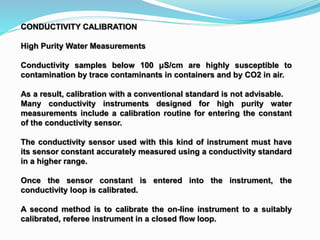Conductivity measurement involves measuring how well a solution conducts electricity. There are two main types of conductivity sensors:
1. Contacting sensors which use electrodes in contact with the solution and can measure low conductivities. They are susceptible to fouling.
2. Inductive (toroidal) sensors which do not contact the solution and can be used in dirty applications. They require a minimum conductivity of 15 μS/cm.
Proper calibration and temperature compensation are important for accuracy. Contacting sensors are calibrated using standard solutions while inductive sensors require in-situ calibration accounting for installation effects. Temperature compensation considers the nonlinear increase in water conductivity and solute type.

































